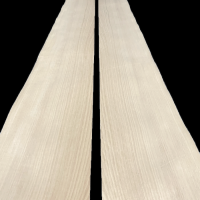
Aniegre Quarter-cut Veneers 330 x 22 cm
Aniegre Quarter-cut Veneers 330 x 22 cm
Genuine wood sliced-veneer sheets, in sequence.
Length: 330 cm.
Width: 22 cm.
Thickness: 0.5 mm.
Sold by the sheet.
These photos are taken from the veneer sheets you will receive.
Aniegre Quarter-cut Veneers 330 x 22 cm
Genuine wood sliced-veneer sheets, in sequence.
Dimensions:
Length: 330 cm.
Width: 22 cm.
Thickness: 0.5 mm.
Measurement scaling:
Dimensions are measured at the small end.
- Width rounded to the covered centimeter: 15.8, giving 15 cm.
- Length rounded to 5 centimeters: 257, giving 255 cm.
Product Description:
Genuine wood-sliced veneer sheets.
These veneers are raw without a finish or any fleece back.
The veneer surface is similar to plain wood. However, it will be preferable to forecast a light sanding after gluing.
The veneers are offered here as wood-sliced sheets of one and unique thickness.
Both faces of these veneers are the same, without fleece back or glue.
Even if the veneer's sides had been cut relatively straight, it isn't a precise parallel clipping, and some veneers may have kept the decreasing shape of the tree, wider at the bottom end and narrower at the top end.
Some veneers' sides occasionally have unclipped wane traces, but our veneers are measured at the narrowest, as explained in the paragraph "dimensions."
As genuine natural wood, all finishing products are acceptable as long as they are meant for wood usage.
The choice of the finished product must be consistent with the final usage realization.
The Species:
Common Names:
Aniégré, Mukali, Tanganika, and Grand-Bassam Walnut.
Note:
In the 1970s, some French veneer producers named the wood "Grand-Bassam Walnut" because they wanted to keep the name of the secret wood as long as possible and thus gain an advantage over their competitors. Based in the Ivory Coast, these veneer producers were inspired by the Ivorian beach of Grand-Bassam, which is known for its fine sand and coconut trees.
Botanical Name:
Aningeria altissima, robusta, superba.
Origin:
West African wood to Central Africa.
Appearance:
Aniégré is a wood with a light hazelnut color and a slight pink hue. It offers a regular and homogeneous structure, which is a delight for those who are looking for a clean look. It has a firm grain with a few open pores like walnuts. It takes stain particularly well and is, therefore, often used as a substitute for Walnut or Cherry, depending on the stain chosen.
Note:
For several years now, with the growing interest in Aniégré, Longhi veneers have sometimes been offered as Aniégré. Although Longhi resembles Aniégré in a lighter color, it does not have the same advantages, especially in terms of finish.
Properties:
Weight: 550 Kg / m3, average at 10 - 12% humidity.
Janka Hardness: 4380 Newton. For comparison, Oak is at 4980 N, and Poplar is at 1650 N.
Elasticity: 10.95 GigaPascal, for comparison: Ash is 12.31 GPa and Poplar is 9.75 GPa.
Note:
Aniégré is mainly found in veneer and much more rarely in solid wood. Indeed, this wood is very abrasive and quickly dulls saw and planer blades.
Uses:
Since the 1970s, its use as veneer in the manufacture of furniture and interior carpentry has been a classic.
In its curly version, Aniégré is one of the rare and precious woods used for high-end decoration and instrument making.
Use of the veneers:
Cutting:
Veneers can be easily cut with a utility knife.
For straight cuts, the best results are obtained with a veneer saw.
Use a fretsaw, scalpel, or veneer knife for curved cuts.
Always allow for a slightly larger veneer sheet than your intended surface. This will allow you to adjust the size after gluing for a clean finish.
A flush trimmer can also be used to trim the veneer after gluing.
When cutting with a utility knife or veneer knife, it is best to cut with the grain of the wood. To check this, run your finger along the edge of the sheet. The direction that feels smoothest is the ideal direction for cutting.
Gluing:
Several types of gluing are possible.
With vinylic glue, the veneer is pressed over its entire surface.
With neoprene glue for all surfaces, especially non-porous surfaces, by applying two coats of glue and marouflage.
With animal glue, such as hide, sinew, or bone glue.
With vinyl glue and an iron, apply two thin coats of glue to each piece. This technique should only be used if other gluing techniques are not possible.
Sanding:
Veneers and all our products are wood and can be sanded according to their thickness.
Regardless of the thickness of the veneer, please do not use a belt sander, as this could pierce it.
With a 0.6 mm veneer, lightly sand with 120 grit and then finish with 180 or 240 grit. With an orbital sander, 180 grit is already sufficient for most applications.
Finishing:
All finishing products generally used for wood are suitable for finishing our products. For example, you can use a varnish, wax, paint, or oil.
However, ensure that the product you want to use is compatible with the final use of your creation.
Packing:
Veneers are rolled and well protected in a strong carton chosen to resist somewhat vigorous handling and to be delivered in good condition.
More info:
If you need more info, please look at our TUTORIALS; you might find some valuable tips.
Please contact us for any additional information by email or phone.
Data sheet
- Species
- Aniegre
- Thickness group
- Standard
- Grade
- Quarter-cut
 English
English




